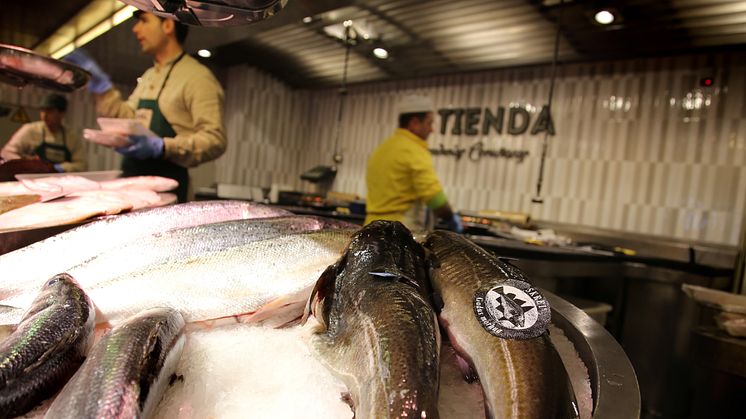
Press release -
Fall in Norwegian seafood export value despite growth in volume for some species
Norway exported seafood worth NOK 8.7 billion in February. This figure represents a decrease of NOK 482 million, or 5 per cent, compared with February last year, and continues the downward trend that started in January.
"Although seafood markets are still strongly affected by the corona pandemic, the value of seafood exports in February is the second-highest February on record. This is partly because record-high volumes of individual species like salmon and herring have been exported", says Renate Larsen, CEO of the Norwegian Seafood Council.
A nuanced picture
In February, most species' export value fell, except for king crab and herring, compared to the record-strong February of 2020.
"A year ago we saw historically high prices for salmon and cod, and that was before the pandemic struck and reduced the sale of seafood in hotels and restaurants globally. It should also be mentioned that the picture is nuanced and that there is still significant uncertainty associated with future export development for individual species", says Renate Larsen.
- Seafood exports totalled NOK 8.7 billion in February.
- There has been a decrease in value of 5 per cent, or NOK 482 million, compared with February last year.
- Poland, Denmark and the USA were the largest markets for Norwegian seafood in February.
Strong salmon growth to China and Italy
- 95,600 tonnes of salmon worth NOK 5.4 billion were exported in February.
- Export volume increased by 20 per cent.
- Export value fell by NOK 306 million, or 5 per cent, compared with February last year.
- Poland, France and the USA were the largest markets for Norwegian salmon in February.
"When the corona pandemic started, China was the country that first shut down society, which had a significant consequence for salmon exports. In Europe, Italy was the hardest hit in the first phase of the pandemic. Here, the fear of infection led to a fall in demand for salmon even before the country detected coronavirus. In February this year, it was precisely these two markets that showed the most robust growth in value for salmon exports", says Paul T. Aandahl, Seafood Analyst with the Norwegian Seafood Council.
According to the Norwegian Seafood Council's seafood envoy to Italy, Trym Eidem Gundersen, the increased salmon sales are the result of several regions receiving relief from the coronary restrictions in February.
Lower prices
"The fact that there is no longer a curfew also means that people are visiting shops more often, which is positive for the sushi market. Among other things, the relief means that the restaurants can stay open until 18.00. The low price compared to last year also plays a significant role. Unfortunately, there have been new restrictions, which may mean that demand will fluctuate in the future", says Gundersen.
Norwegian salmon to China continues to show good development into the new year.
"The first two months of the year mean extended holiday periods in China with typically higher demand for salmon. Growth compared with the same time last year must be seen in light of the fact that the corona pandemic hit China in February last year. At the same time, Chinese New Year in 2020 was celebrated two weeks earlier than this year", says Victoria Braathen, the Norwegian Seafood Council's seafood envoy to China.
A decline for trout
- 3,900 tonnes of trout worth NOK 292 million were exported in February.
- Export volume fell by 20 per cent.
- Export value fell by NOK 61 million, or 20 per cent, compared with February last year.
- The USA, Belarus and Japan were the largest markets for Norwegian trout in February.
Growth for fresh cod
- Norway exported 11,000 tonnes of fresh cod, including cod, worth NOK 412 million in February.
- Export volume increased by 25 per cent.
- Export value increased by NOK 10 million, or 2 per cent, compared with February last year.
- Denmark, Poland and Spain were the largest markets for fresh cod from Norway in February.
Spain falls in love with skrei
- 1,700 tonnes of cod worth NOK 71 million were exported in February.
- Export volume fell by 11 per cent.
- Export value fell by NOK 15 million, or 18 per cent, compared with February last year.
- Denmark, Spain and Sweden were the largest markets for cod in February.
Exports of fresh cod to Spain in February fell by 10 per cent, but much enters the country via Denmark.
"The main reason for somewhat weaker exports to Spain is a late start to the cod season. The trend for exports of fresh cod is nevertheless positive, and this is especially true for cod. In February, Spain had the strongest growth in imports of cod and increased its import volume by 14 per cent", says Eivind Hestvik Brækkan, Seafood Analyst with the Norwegian Seafood Council.
"We see that landings are now increasing, and we expect a new record volume of cod for Spain this year. Lower prices than last year contribute to increasing consumption", says Bjørn-Erik Stabell, the Norwegian Seafood Council's Seafood Envoy to Spain.
Decrease in value for frozen cod
- Norway exported 6,700 tonnes of frozen cod worth NOK 251 million in February.
- There has been a decrease in volume of 19 per cent.
- Export value fell by NOK 131 million, or 34 per cent, compared with February last year.
- The United Kingdom, China and Lithuania were the largest markets for frozen cod from Norway in February.
The trend of an increased volume share to the EU continues, and after an increase to China in January, export volume to China was 44 per cent lower than in February last year. The decrease in volume is mainly due to frozen whole cod, 22 per cent lower than in February last year.
"Throughout the corona pandemic, we have seen that storage-friendly products have had an increasing demand in the grocery trade. Among other things, this has led to an increase in frozen cod fillets' consumption in all our largest markets", says Eivind Hestvik Brækkan, Seafood Analyst with the Norwegian Seafood Council.
A new market opens up for clipfish
- Norway exported 6,800 tonnes of clipfish worth NOK 266 million in February.
- There is a reduction in volume of 8 per cent.
- Export value fell by NOK 123 million, or 32 per cent, compared with February last year.
- The Dominican Republic, Portugal and Brazil were the largest markets for Norwegian clipfish in February.
"This month has seen record volumes of exports to the Dominican Republic, which for the first time tops the list of clipfish markets. The main reason is that Portugal and Brazil, which have traditionally been the largest markets for clipfish, had a significant decrease in volume in February, of 59 and 42 per cent, respectively", says Eivind Hestvik Brækkan, Seafood Analyst with the Norwegian Seafood Council.
Clipfish consumption in Portugal has increased during the pandemic and increasing home consumption has managed to compensate for lost sales in the hotel, restaurant and canteen segment.
"Part of the decline in clipfish exports to Portugal in February may be due to an earlier Easter this year than last year and that many importers have shopped earlier for Easter sales", says Eivind Hestvik Brækkan.
Decline for salted fish
- Norway exported 1,900 tonnes of salted fish worth NOK 83 million in February.
- There is a decrease in volume of 7 per cent.
- The value fell by NOK 30 million, or 27 per cent, compared with February last year.
- Greece, Portugal and Brazil were the largest markets for Norwegian salted fish in February.
"Brazil did not import salted fish from Norway in 2020, but in both January and February, this year imported salted fillets of cod. In February, this country was our third-largest salted fish market", says Eivind Hestvik Brækkan, Seafood Analyst with the Norwegian Seafood Council.
Big drop for stockfish
- Norway exported 282 tonnes of stockfish worth NOK 49 million in February.
- There is a decrease in volume of 40 per cent.
- The value fell by NOK 44 million, or 48 per cent, compared with February last year.
- Italy, Nigeria and the USA were the largest markets for Norwegian stockfish in February.
Strong herring month
- Norway exported 58,000 tonnes of herring worth NOK 554 million in February.
- The volume increased by 51 per cent.
- The value increased by NOK 180 million, or 48 per cent, compared with February last year.
- Lithuania, Nigeria and Poland were the largest markets for Norwegian herring in February.
February was a strong month for herring exports, and we must go back to 2012 to find similar values and volumes.
"This is because the quota for Norwegian spring-spawning herring increased by 25 per cent from last year and is at its highest level since 2012. In total, 200,000 tonnes were landed in January and February, an increase of 13 per cent compared with the same period last year", says Jan Eirik Johnsen, Responsible for Pelagic Species in the Norwegian Seafood Council.
Increased consumption
Prices are holding up well as well as increased volumes for all products.
"The corona pandemic has led to increased consumption of herring in several markets. Although there are restrictions in the restaurant segment in several places, market players prepare for an opening in herring availability. Overall, demand has been good, and besides, restricted access to large herring has resulted in increased prices", says Jan Eirik Johnsen.
Good demand for mackerel
- Norway exported 29,000 tonnes of mackerel worth NOK 445 million in February.
- This marks a decrease in volume of 14 per cent.
- Export value fell by NOK 110 million, or 20 per cent, compared with February last year.
- South Korea, Vietnam and Japan were the largest markets for Norwegian mackerel in February.
For mackerel exports, a record-breaking January was followed by another good month. February 2020 was the best, both in export value and volume, but February 2021 enters a healthy second place by export value and third place by export volume.
"Demand for Norwegian mackerel is excellent in the markets, and the critical consumer markets of Japan, South Korea and Taiwan are showing strong growth. In particular, exports to South Korea have had formidable growth so far this year, with an export value of NOK 260 million and a volume of 17,000 tonnes. This is an increase of 92 per cent in value and 118 per cent in volume compared with the same period in 2020, says Jan Eirik Johnsen, Responsible for Pelagic Species with the Norwegian Seafood Council.
Capelin
- After two years without capelin fishing, Norway received a quota of approx. 42,000 tonnes in Icelandic waters.
- The entire quota was fished between 1 and 19 February.
- Norway exported 6,000 tonnes of capelin worth NOK 108 million in February.
- China, Japan and Ukraine were the largest capelin markets in February.
"After several years where neither Norway nor Iceland has fished for capelin, good interest in capelin has been reported in the markets. In February, the average price of exported capelin was NOK 18.02 per kg, which is historically high compared to exported volume", says Jan Eirik Johnsen, responsible for pelagic species with the Norwegian Seafood Council.
King crab
- Norway exported 235 tonnes of king crab worth NOK 82 million in February.
- This marks an increase in export volume of 100 per cent.
- Export value increased by NOK 41 million, or 101 per cent
- South Korea, Hong Kong SAR and the Netherlands were the largest markets for Norwegian king crab in February.
Prawn
- 843 tonnes of prawn were exported in February with a value of NOK 66 million.
- This represents an increase in export volume of 4 per cent.
- Export value fell by NOK 2 million, or 3 per cent, compared with February last year.
- Sweden, the United Kingdom and Finland were the largest markets for Norwegian prawn in February.
Topics
Categories
The Norwegian Seafood Council works with the Norwegian fisheries and aquaculture industries to develop markets for Norwegian seafood through local market intelligence, market development and reputational risk management. The Seafood Council is headquartered in Tromsø and maintains local representatives in twelve of Norway's most important international markets. The Norwegian seafood industry finances the activities of the Norwegian Seafood Council via a tariff on all Norwegian seafood exports.
The Norwegian Seafood Council is a public company owned by the Ministry of Trade, Industry and Fisheries.



